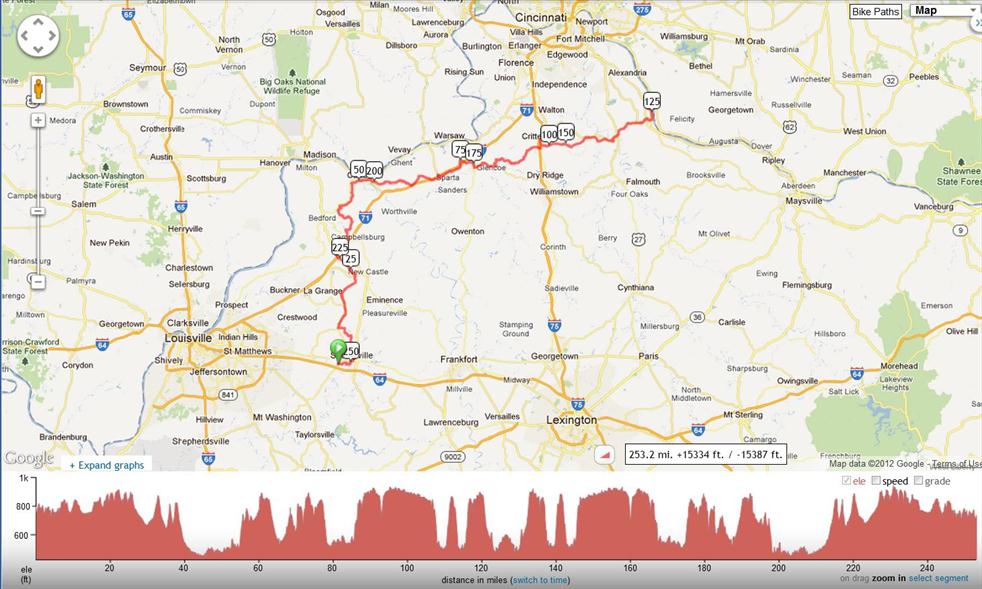brightness to the maximum. I could see every pothole and crack in the road far off into the distance. Of course, every brevet
rider also wears enhanced reflective gear and uses multiple taillights-see and be seen!
Although I rode more than 140 miles alone, I was relieved to come across a fellow rider repairing a flat about 35 miles
from the end. I helped him finish the job, and then we rode the rest of the way in together. A stalwart companion casts a
cheerful light when travelling down murky corridors in the wee hours of the morning. I was also grateful for my GPS which
helped me anticipate the proper turns along tenebrous unlighted roadways.
We arrived a little after 1:00 a.m. and peeled ourselves off the bikes. (At least, that's what it felt like.) I could have used a
hot pizza and maybe a beer, but alas, all the stores were closed; so, I drove straight home to where my lovely bride of 36
years was waiting to hear all about it.
Map of the 400 km route available here: http://ridewithgps.com/trips/607714

YOU DID WHAT?
By Dr. Larry Preble
May, 2012
Ah, a good night's sleep, breakfast out, and an hour long massage are just what the doctor ordered. I just finished my first
400 Kilometer brevet which was actually slightly more than the 400 km advertised. For the metrically impaired, I ended up
with 251 miles on the odometer.
In my office today, people asked, “You did what?!” I am becoming almost reluctant to elaborate, because some think I’m
joking, or perhaps a candidate for the loony bin. It’s hard to explain, because long distance riding is an acquired taste.
Randonneuring is a long distance cycling sport characterized by a series of rides of 200 km or more. The brevets, or
randonées, are timed, non-competitive events. Riders are expected to complete each course within a specified time period
with emphasis on self-sufficiency. Equal recognition is given to all riders regardless of their finishing order.
Our motley collection of 15 randonneurs left out of Shelbyville and traversed the hilly hinterlands of northern Kentucky. We
passed through Campbellsburg, Carrollton, Sparta, Crittenden and turned around just past Carrtown on the Ohio border.
According to a GPS mapping website, “ridewithgps.com,” we climbed 15,334 feet during the brevet (and, of course,
descended that many feet too.) I burned about 15,000 calories which explains why, despite having consumed well more than
4,000 calories yesterday, I still feel hungry this morning and am down a few pounds on the scale.
I made one rookie error on the way out. All my previous brevets had control stops with food, spaced every 25 to 35 miles.
When I pulled myself out of bed just before 2:00 a.m., I didn't feel hungry. I thought, "Breakfast can wait. We start the ride
at 4:00 a.m.; in a couple of hours we will stop, and I can grab some food." Mais non!
I started out riding near the front of the pack and was surprised when nobody stopped for food as we passed through
Campbellsburg. Our first control point was not until mile 70! The experienced brevet riders had all brought food with them
to eat as they rode-silly me! Of course, I could have stopped on my own, but was loath to leave my riding companions so
early. I learned two things: 1.) Yes, I can ride 70 miles with no breakfast and nothing but water to drink and 2.) This is a
terrible idea.
When I arrived at the first control point, I was beyond being hungry. I greedily consumed over 2,000 calories before getting
back on the bike. I ate two sandwiches, two huge chocolate bars, some crackers, and drank copious amounts of chocolate
milk-oh yes, so much better!
Then there was the rain: One rider had trusted the initial forecast for the rain to subside and
had not brought sufficient clothing. He spent an hour and a half off the bike warming up at a
store. He later caught up and made a strong finish-talk about tough! Fortunately, I'm used to
riding in the rain and had prepared for it. My gear kept me warm, if not entirely dry; even
so, it is always welcome when the rain stops.
Darkness: I am always on edge when riding at night. Careless motorists, unseen potholes,
animals darting out into the street and general fatigue can spell trouble for the unwary rider.
I was well pleased with the careful route planning shown by the organizer, Steve Rice. His
chosen course was timed to keep us on nearly deserted roads during the dark hours. I recall
one stretch by the little Kentucky River and beyond where I saw not one vehicle for over an
hour.
Some months ago, I purchased one of the brightest light sets available, rivaling an
automobile's headlights when set to full power, but also adjustable down to a low level to
conserve battery power as needed. Any time I went flying down a hill, I would boost the
Larry Preble--All wet in Crittenden
Here’s what Wikipedia has to say about Randonneuring: http://en.wikipedia.org/wiki/Randonneuring
